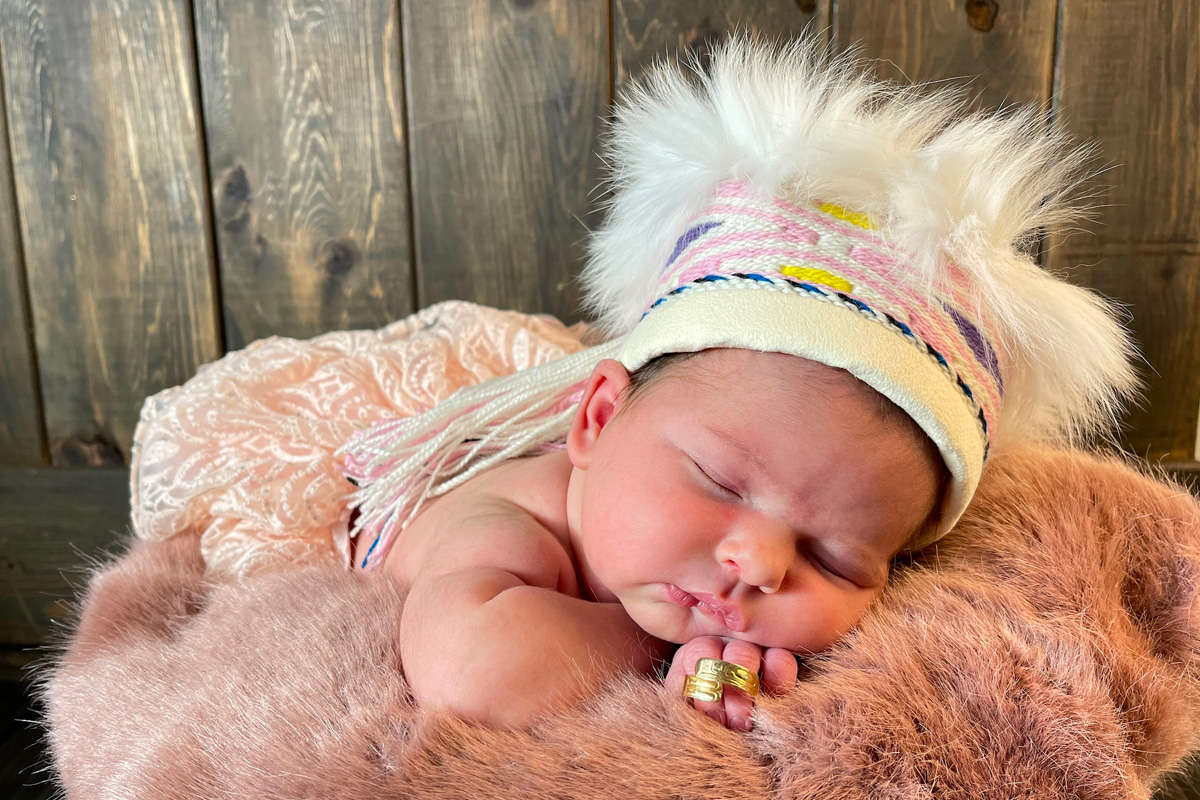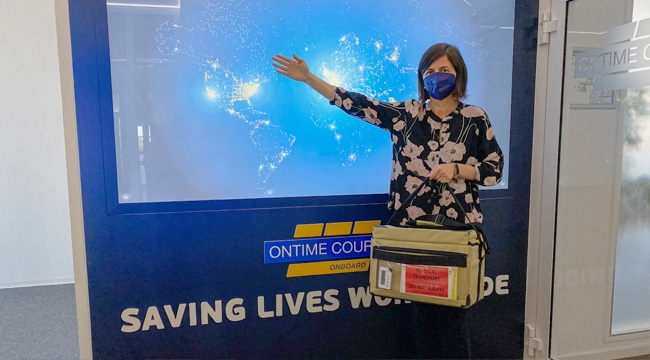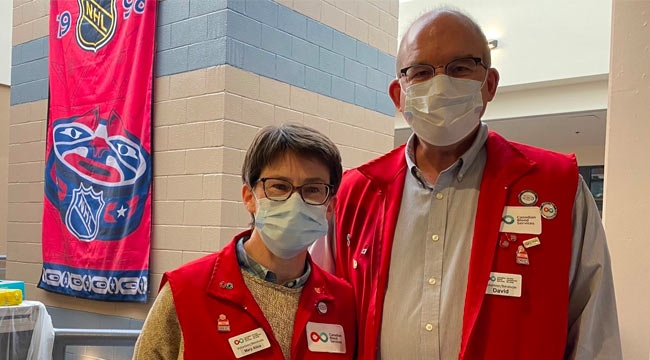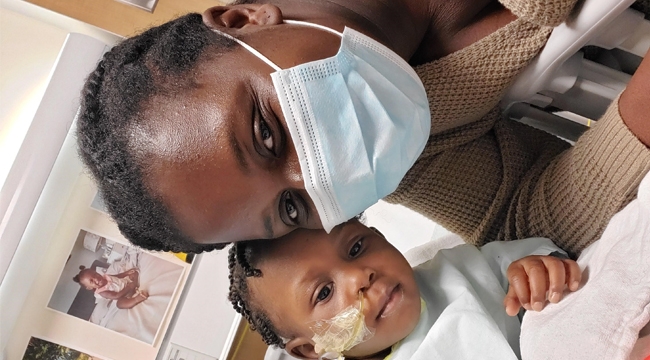How an Indigenous cord blood donor was inspired by a patient
Lena Mallary saw cord blood save a child’s life shortly before she welcomed her own ‘miracle baby’ with Cory Greenhalgh
When Lena Mallary fell in love with Cory Greenhalgh last year, they had no plans for children. But they were thrilled to welcome their daughter Flora-Lyn Russ last summer.
“We found out one month into our relationship that we were pregnant,” says Lena, who’s Haida and comes from the Maaman Gitanee clan in Old Massett, B.C. “For us, getting pregnant should not have been possible without fertility treatments, but it happened.
“Our baby was an incredible surprise and we wanted to share that miracle with a patient by donating her cord blood.”
How can you donate your child’s cord blood?
Storing cord blood: why choose to donate to a public bank?

The parents of Flora-Lyn Russ, seen here at the age of two months, registered to donate cord blood. Umbilical cord blood contains stem cells that can be used for lifesaving transplants.
What is cord blood?
After a baby is born, the blood left in the umbilical cord and placenta is rich with lifesaving blood stem cells. With mothers’ consent, Canadian Blood Services’ Cord Blood Bank collects this cord blood at hospitals in Edmonton, Alta., Vancouver, B.C. and the Ontario cities of Ottawa and Brampton. It is held in the bank for future use by any matching patient in need of a stem cell transplant. Just like stem cells found in bone marrow or circulating blood, those found in cord blood can be used to treat more than 80 blood diseases and disorders, including life-threatening cancers.
Every year, hundreds of Canadian patients require stem cell transplants to save their lives, and only about a quarter of them will find matching donors within their own families. The rest will need stem cells from adult donors identified through Canadian Blood Services Stem Cell Registry or from cord blood units. No matter the source, a patient’s best hope of a match is in a donor of similar ancestral background. We need donors from as many diverse ethnic and mixed-race backgrounds as possible, including donors of Indigenous background.
That said, cord blood transplants require a less precise genetic match between patient and donor than transplants which use adult stem cells. This makes cord blood a great option for those without a match in the adult registry. Also, since cord blood stem cells are stored for use anytime, they can generally be made available to a patient more quickly than those obtained through a search for a matching adult donor. In fact, cord blood has become an even more vital resource for patients during the COVID-19 pandemic, because of the worldwide impact of COVID-19 on stem cell transplantation and the shipping of cells from overseas donors to patients. Although our public cord blood bank collected fewer cord blood units during the pandemic, we have shipped more units for transplants in Canada and abroad this year than in the past four years.
Read our 2020-2021 annual report

Lena Mallary and Cory Greenhalgh’s sons Harvey Russ (right) and Gavin Greenhalgh (left) were excited to welcome their baby sister Flora-Lyn Russ (middle) when she arrived last summer. Their parents donated Flora-Lyn’s cord blood to Canadian Blood Services’ Cord Blood Bank.
Cord blood donation inspired by a lifesaving transplant
Lena and Cory met at a pub in Richmond where Lena worked a few nights every week. On their first date, Cory says he knew that they would be together forever, and they later joked about it. A few days after that date, they expressed their love for each other, but Lena needed him to understand something important before she could commit to a relationship.
“I told him that if he wanted more kids, I wasn’t the woman for him, as it was likely I couldn’t have any more children,” she says. “The day I learned I was pregnant, Cory said it was a sign that we were meant to be, and that completely sealed our fate.”
When they met, Cory and Lena each had a son from a previous relationship, but neither had donated cord blood after a birth. This time, however, they had a powerful motivation to join Canada’s Lifeline.
“After my mom was diagnosed with breast cancer in 2019, one of my son’s best friends was diagnosed with leukemia that same year, and he needed stem cells to help in his recovery,” says Lena. “The little boy was eventually cured of his cancer with cord blood stem cells at the same time we got pregnant.
“So, there was no question in our minds that we had to donate cord blood.”

Lena Mallary and Cory Greenhalgh donated cord blood after the birth of their daughter. They had seen cord blood stem cells save the life of a young family friend.
Your little miracle can help save someone’s life
Before Lena set out to learn about cord blood donation, she hadn’t realized there were so many ways to give to Canadian Blood Services. In her own words, “I often thought of the organization only as a blood collector.”
But reading about cord blood also helped her learn that financial donors are a critical part of Canada’s Lifeline. In fact, in 2011, when Canadian Blood Services launched the Campaign For All Canadians — a fundraising effort to help build a national, public cord blood bank — financial donors contributed $12.5 million. And since the public bank was established in 2013, more than 37,000 mothers have donated their baby’s cord blood.
By registering to donate cord blood, donors give hope to patients in need and also reduce the chance that the cord blood and placenta will be simply discarded as medical waste. However, it’s important to note that not all collected cord blood units are suitable for banking. Sometimes — for reasons that are not connected to the health of the mother or baby — their volume is insufficient, or they don’t contain enough stem cells to be used for a stem cell transplant. In such cases, with the mother’s consent, such units are dedicated to our Cord Blood for Research Program, which helps to advance stem cell therapies and transplantation practices.
How donated umbilical cord blood saved the life of another newborn
Learn more about the use of cord blood for research
“After watching our friends’ son go through the journey of needing stem cells, we saw how incredibly important it is to try and help whenever we can,” says Lena. “The little boy’s experience opened my eyes to all the work that Canadian Blood Services is doing to help patients, and donating my baby’s cord blood was a fulfilling way for me to play my part.”
This World Cord Blood Day, and every day, we encourage expectant moms to register online to donate their babies’ cord blood. And if you’re between the ages of 17 and 35, you can join Canadian Blood Services Stem Cell Registry by requesting a donor swab kit online. You can also support stem cell recruitment and education initiatives by making a financial gift at give.blood.ca.



